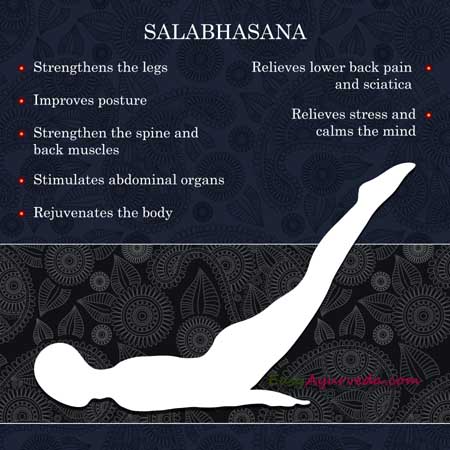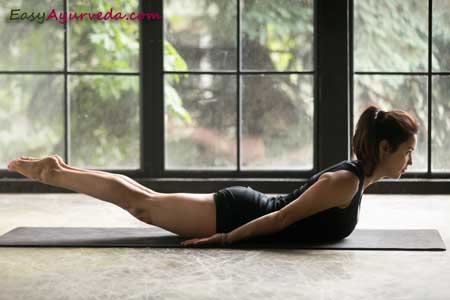Salabhasana Locust Pose or Grasshopper Pose, Method, Uses, Ayurveda View
Article by Dr Raghuram Y.S. MD (Ay) & Dr Manasa, B.A.M.S
Salabhasana is an asana in which the person performing the asana assumes the shape of a Shalabha or Locust. Therefore this asana is called as Salabhasana or Locust (Grasshopper) Pose.
Table of Contents
Word meaning
Salabhasana or Locust / Grasshopper Pose
Meaning –
Salabha = Locust / Grasshopper
Asana = Pose, Posture
This asana is one among the baby backbends. Though Salabhasana looks simple, it is a challenging pose.
Preparation for Shalabhasana
- You must keep your stomach empty before doing the Salabhasana. You need to have your meals 4-6 hours before starting to perform this asana. This enables digestion of food and clearance of stomach, such that your stomach remains empty by the time you begin the asana. The energy derived from the food will enable you to perform the asana effortlessly.
- Keep your bowel and bladder clean and clear before performing the asana.
- It is best to practice Salabhasana first thing in the morning for obtaining optimum benefits. If it is not possible to do the asana in the early hours of the morning due to other schedules and priorities, you can readily do it in the evening.

Method
Method of doing Salabhasana
Positioning for the Asana
- Lie on your abdomen (belly, tummy) on the mat.
- Place your hands by your side.
Performing and getting to the Salabhasana
- Slowly inhale as you lie down on the ground.
- As you inhale slowly lift up your legs and upper torso.
- Using your inner thighs, lift your leg upwards without bending your knees.
- Your weight should rest on your lower ribs and abdomen.
- You have come into the Locust pose now, your body making an arc with the abdomen and chest being the point of contact with the floor.
Release from the asana and coming back to the point of start
- Hold in this pose for about one minute.
- Slowly bring down your arms, lower limbs and torso to the ground and sleep on your tummy, assuming the position in which you had started. This forms the release from the asana.
Tips for Beginners
Beginners for Salabhasana can just start by lifting their legs, keeping their upper part of the body on the ground. Hands may be used for additional support.
Advanced pose
Advanced pose (variation of Locust Pose)
- To increase your stretch while you are in this asana, you must gently bend your knees, instead of stretching out your legs, such that your calf muscles are perpendicular to the floor. After making sure that your legs are in position, slowly lift your upper body – the torso, the arms and the head – and lift your knee joints as high as you can comfortably lift. As you lift the upper torso, head and arms, lift the knees as far away from the floor as possible.

Purva and Paschat Asanas
Purva Asanas (Preparatory Asanas)
Before Salabhasana, you can do one or more of the below mentioned Asanas –
- Bhujangasana – Cobra Pose
- Gomukhasana
- Setu Bandha Sarvangasana
- Supta Virasanaa – Reclined Hero Pose
- Urdhva Mukha Svanasana
- Virabhadrasana
- Virasana
Paschat Asanas (Post-Salabhasana Poses)
After performing Salabhasana, one can perform –
- Dhanurasana
- Sarvangasana
- Ustrasana – Camel pose
- Bharadvaja’s Twist
- Setu Bandha Sarvangasana
Duration, health benefits
What time should be spent in the pose while doing Salabhasana?
One can stay in Salabhasana for 30-60 seconds at a stretch.
Health Benefits of Salabhasana
- Salabhasana are strengthened the arms, thighs, shoulders, legs, calf muscles, and hips.
- This asana tones and strengthens the back. It is a good back pain remedy and also useful for relieving sacroiliac pain.
- Salabhasana helps one to have and maintain a healthy posture, corrects postures and cures disorders caused by wrong postures.
- This asana regulates Metabolism.
- Shalabhasana helps in weight loss and thus is an effective cure for obesity and overweight.
- This asana helps to reduce stress and tension.
- The asana improves concentration, promotes calmness and focus.
- The locust pose invigorates the entire body, stimulates the internal organs
- It enhances the circulation of blood.
- This asana provides relief from sciatica, slipped disc, varicose veins, hemorrhoids and low back pain.
- This asana helps to regulate the acid-base balance in the body.
Effect of Shalabhasana – Ayurvedic view:
Effect on Doshas
Effect of Grasshopper pose on Doshas and Subtypes
Salabhasana balances and calms the vitiated Vata.
Salabhasana helps in normalizing and balancing the equilibrium between the Prana Vayu, Udana Vayu and Vyana Vayu. The synchronization of these three Vata subtypes will help in proper circulation of blood and nutrients in the body, oxygenation of all the cells and provides good energy. This balance will help in reduction of stress and tension, keeps the mind and senses serene. It will also enable you in maintaining good posture and balancing self.
Salabhasana helps in maintaining the sync between the Pachaka Pitta and Samana Vayu, thus helps in regulating metabolism.
Effect on Dhatus
Effect of Salabhasana on Dhatus –
Locust Pose strengthens and stretches the mamsa dhatu or muscle tissue, especially the muscles of the arms, thighs, legs, back and calf muscles.
Salabhasana strengthens the asthi (bone tissue) and asthi sandhis (bony joints) especially those of shoulders and hips, makes movements therein easy and flexible.
Salabhasana helps in destroying the accumulated fat in the body. It also helps in preventing the accumulation of fat in the body and in blood vessels. Thus Salabhasana helps in treating obesity and overweight.
Salabhasana, what it promises!
Salabhasana is an asana which is said to resemble a locust or grasshopper at rest. But Salabhasana is an active pose and doesn’t involve rest. It is not easy to do that. It takes a lot of skill and effort on the part of the doer to get into this pose, just like the locust which puts effort, to make that jump so as to throw itself backwards.
When you practice this asana, just getting into the pose and staying there is intense. This asana teaches you the art of focusing and also to plug in your mind to work. You learn to remain calm, yet be alert.
Salabhasana works as a blueprint backbend. This pose allows you to understand and figure out the right alignment for other backbends like Dhanurasana, the Urdhwa Mukha Svanasana and Chakrasana.
This pose strengthens your abdomen and back. It also opens your chest. It helps your body to become more aware of itself. With practice, you will understand what is required for a balanced backbend. With Salabhasana, your body is thoroughly strengthened so as to help you with arm balancing poses, inversions and asanas that require the engagement of the abdomen.
Generally the backbend poses use the limbs to push the body against gravity. But when it comes to Salabhasana, the hands and the legs are suspended. Therefore your back and abdomen (tummy) need to work harder to lift your body.
Impact on Chakras
Salabhasana helps in stimulating and balancing the Swadishtana Chakra (Sacral Chakra) and Manipura Chakra (Solar Plexus). The asana helps in enhancing the agni – metabolic fire. Balance of these Chakras, mainly Manipura Chakra enhances your will power, optimism and energy. It also helps in increasing self confidence and to control your emotions.
Contraindications and precautions
Who should not do? (Contraindications and precautions for doing Salabhasana)
Patients suffering from below mentioned conditions should avoid doing Grasshopper Pose–
- Headache
- Migraine
- Neck injury
- Spinal injury
- Pregnant women should avoid this pose
Just Before Finish
Salabhasana is a very good pose to strengthen the lower back and is a good remedy for back pain and discomfort. It also strengthens the shoulders, thighs, legs and hips. It corrects posture and provides balance. In this article, I have covered in detail about Shalabhasana along with the method of doing the asana, the indications and health benefits and contraindications.
Click to Consult Dr Raghuram Y.S. MD (Ayu) – Email / Skype









